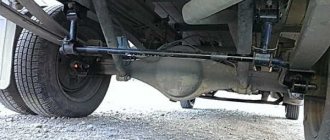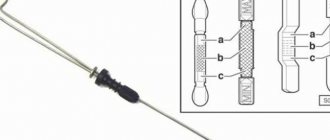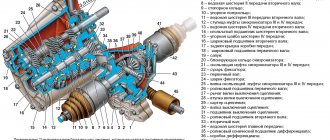The gearbox can be considered one of the main components of a car. With its help the car is set in motion. Drivers should monitor lubricant volume at least once every six months. You need to know that untimely checking of the oil in the gearbox can lead to its premature failure.
If you don't know the oil level in your vehicle's gearbox, follow the tips below.
Reference
In a manual gearbox, transmission fluid of a certain quality group. For manual transmission it is AP/GL-4 with a viscosity of SAE 75W-85. The required volume of technical fluid for mechanics is 2.3-3.1 liters. Manufacturing plants recommend replacing the used product. It is recommended not to mix products of different brands. Approximate replacement time after 90 thousand kilometers or after three years of vehicle operation. Checking the oil level in the gearbox is carried out after 15 thousand kilometers of the car.
The inspection and replacement period may be reduced if the vehicle was operated in difficult road and climatic conditions.
Why is a replacement necessary and when to change the oil in a manual transmission?
So, a manual gearbox is designed for a stepwise change in the gear ratio, in which the choice of gear is carried out directly by the driver himself.
During operation, increased friction is created between the moving parts of the manual transmission and they heat up. In this case, the oil lubricates all parts of the gearbox, removes excess heat, thereby preventing rapid wear and damage to loaded gearbox elements.
Accordingly, the oil’s chemical composition is close to the base one. This entails the loss of properties laid down by the manufacturer and providing specific features of certain lubricating fluids.
In simple words, the oil in a gearbox, in which the additive package has worked, foams under the influence of loads, loses its lubricating properties, viscosity parameters change, etc.
About breakdowns of the box of the mechanical principle of operation
The symptoms of low oil level in a manual transmission are described below. The main “technical diseases” include:
- Spontaneous oil leakage: sealing seals and gaskets are damaged. The crankcase may have become loose.
- Extraneous noise in the box. The synchronizer may have failed and/or the gears may have worn out.
- There were difficulties turning on the manual transmission. Parts of the switching mechanism have broken down.
- The gears are switched on independently. Problems with the locking device, synchronizers, or gears.
In any case, after restoring the manual transmission, an oil change will be required. It is important not only to replace the fluid, but to know how to check its level.
There are a number of ways to check the level of a technical product, which will be discussed below.
Incorrect amount of liquid
avtoexperts.ru Is the oil in a Kia Rio automatic transmission changed
? There are situations when there is less fluid than required, and there are times when it is higher. In any case, when there is more or less lubricant, this threatens with bad consequences for the box. When the oil level in the automatic transmission is less than it should be, the temperature regime immediately changes, the efficiency decreases sharply, and the pump can also capture air with the liquid, which disrupts the lubrication process of all units, the pressure in the box decreases, which is why it can one of the gears stops turning on.
When there is too much lubrication, it can cause the oil to reach the rotating gears, and it will foam in the same way as in the case of low lubrication. After the liquid foams, it will pour out through the breather, as a result of which the entire box outside will be stained.
Dipstick control.
In this case, an independent check of the lubricant volume is as follows. You need to find a level place and park the car. Allow the oil to stand for about 15 minutes. Then, you need to open the hood, pull out the dipstick and wipe it with a clean rag, removing any remaining oil. Re-insert the probe into the socket and remove it again. Pay attention to the indicator: if the oil is below o, you need to add it to the specified level. The probe has special cold (+20) and hot (+80) marks. If there is only one scale on the dipstick body, the fluid level is checked after the power unit has warmed up.
Use transmission fluid similar to the product filled in.
Take the manufacturer's recommendations as a basis and follow their instructions. Wait a pause until the new product settles and check the readings again. Repeat the filling procedure if necessary.
Checking transmission oil without a dipstick.
It is necessary to place the vehicle on an overpass with a slight slope and dismantle the protection. This will allow you to top up the transmission lubricant to about. You need to unscrew the filler plug and insert your finger into the hole. You can touch the lubricant. If necessary, add product using a special syringe. A long pipe can be used as a device. What to do if the oil level in the box is low? You need to add liquid, as we already said. Lack of oil in the manual transmission can lead to its premature failure. It is important to promptly inspect the lubricant level. If the first signs of a leak appear, first of all, seals, gaskets, and the reliability of fastening the crankcase and pan are checked. If necessary, worn parts must be replaced with a new set.
How often should you check the gearbox oil?
The oil level in the manual transmission must be checked every 10,000 / 15,000 km. This also applies to automatic transmissions. When using high-quality fuel and driving at a measured pace, the need to change the oil occurs after 60,000-70,000 km. Measuring the oil level can also be done on a cold box, but the final readings will not be accurate.
Low ATF levels have a negative impact on the automatic transmission system. As a result of this, the device begins to experience colossal loads during its operation, which leads to premature erasure of its component mechanisms. Also, because of this, the oil loses its properties.
Thus, in order to check the transmission fluid in the automotive system, the vehicle must be placed on a horizontal surface, the engine must be turned off and the handbrake must be activated, after which the procedure must be started.
Cold check.
Modern car devices make it possible to check the level of the filled substance when it is cold. We emphasize that this verification method will not give an accurate idea of the product poured if the control is carried out at negative t0 without warming up the internal combustion engine.
Initially, you will need to install the machine on a level surface.
Parking the vehicle, even on a slight slope, will distort the indicators and may lead to a violation of the operating mode.
This verification method is used when the design does not provide another option. In severe frost, it is best to perform the test in a warm box or closed garage.
According to the control plug.
How to check the oil in the gearbox in this case. The machine is installed on a special lift or visited in an inspection pit. The control plug is wiped with a clean cloth or rags. The inspection bolt is removed using a special key. As the latter, it is possible to use a hexagon. Please pay attention to this before dismantling. Find out the presence of lubricant and its quantity.
Ideally, the transmission fluid should wet the threads of the inspection window.
If the lubricant is more than the required level, it will flow out spontaneously. If there is not enough lubricating product in the crankcase, you will not be able to see anything.
Upon completion of the verification procedure, the screw should be returned to its place. Please note that underneath there is a washer made of copper.
To completely eliminate lubricant leakage and for the most effective seal, replace the copper washer every time.
Another driving trick. If you don't have a copper washer on hand, pierce the ring over a fire. The metal will become more pliable: reliable protection is guaranteed! This option can be used no more than once or twice.
Assuming control, you should read the instructions for your car. There are two plugs on the body:
- The filler is located on top.
- The control room is on the side.
There are options that they (traffic jams) are combined. In this case, adding the operating substance is done using a special curved watering can as shown in the figure.
Let's summarize what has been said
“Technical treatment” of mechanics is not a cheap pleasure. In addition, if the manual transmission malfunctions, other problems may arise and affect the operation of vehicle components. It is not difficult to protect yourself from such a precedent: it is enough to regularly monitor the permissible level of transmission fluid, guided by the manufacturer’s regulations. Recognize signs of hydraulic fluid leakage and respond in a timely manner to inconsistencies in the operation of the transmission unit.
It is important to regularly check the lubricant level and avoid driving the machine aggressively. It is recommended to fill exclusively worthy fluids into transmission components, thereby extending the operational life of the manual transmission and the vehicle as a whole.
Despite the active growth in the popularity of cars with automatic transmissions, the majority of vehicles are equipped with mechanics. It is the manual transmission that is used as the basic equipment for cars; they are familiar to a large number of drivers.
Unlike automatic transmissions, manual transmissions are characterized by greater susceptibility to influence from the driving style of a particular driver. One person can intensively wear out the box due to sudden and constant switching. In the hands of another driver, exactly the same box retains its service life much longer and remains in excellent condition, all other things being equal.
In order for the manual transmission to operate without problems and for no serious problems to arise, it is the responsibility of the car owner to timely check the oil level in the gearbox. You can do this yourself, since there is nothing complicated in the procedure for checking the amount of lubricant.
But if desired, possible or necessary, there are always car services that can provide the appropriate services. They are important to use if there are problems with the manual transmission, or if you want to perform a complete lubricant change using special professional equipment.
Required volume
Motorists often ask questions about the optimal oil level in manual transmissions. It is important for them to know exactly how much lubricant should be inside the manual transmission for correct and trouble-free operation.
But it is impossible to answer unequivocally what exactly the oil level should be in a mechanical type gearbox. This characteristic is individual for each individual car.
Depending on the brand and model, the boxes may differ in their design and internal volume, which is filled with gear lubricant.
To accurately answer your question, you need to use strictly official documentation. The easiest way to find data on gearbox capacity is in the owner's manual. In the technical documents, the manufacturer prescribes all the necessary characteristics, including the amount of lubricant required for a specific manual transmission installed on the car.
In addition to the quantity, the characteristics of the oil are also indicated. Here we are talking about the degree of viscosity, seasonality and other nuances. Violating them is strongly discouraged.
At the same time, motorists do not fully understand why it is so important to fill in a strictly regulated amount of lubricant. After all, you can fill in a little more, and then you won’t have to top up soon. The nodes will be lubricated more intensively due to an increase in the volume of lubricant. But this opinion is wrong. Oil is poured into the manual transmission strictly in accordance with established standards.
Mechanical lubrication performs several functions:
- lubricates surfaces, preventing their active friction;
- removes heat;
- improves the performance of elements that come into contact with each other;
- removes dirt;
- extends the service life of the entire assembly.
If there is too little oil, it will not be able to fully perform its tasks. Excess is also dangerous, since leaks occur, oil penetrates into systems where it should not be, gaskets and seals fail. And this is a direct road to expensive repairs.
When creating a manual transmission design, the automaker clearly determines at what level the box can work as efficiently as possible, coping with its functions, and without wearing out ahead of time. The appropriate levels are set on the measuring probe, which further help the car owner maintain the parameters set at the factory.
Oil change steps
In Toyotas, changing the lubricating water in the box is divided into 3 types:
Level check
working fluids in a 4-speed automatic transmission of Hyundai cars,...
https://youtube.com/watch?v=Lxx1ScmXAaY
- Intermediate replacement. It is produced in order to remove the old product and then add the latest transmission fluid.
- Standard substitution. It is performed when the time for filling a new lubricant is approaching.
- Full download. It received the title of continuous downloading.
When carrying out work to change the oil in the gearbox, you need to unscrew the drain plug and wait until the oil drains completely.
An intermediate oil change in an automatic transmission is carried out in several steps. At first, the ancient lubricant is carefully combined, after which new fluid is added to the automatic transmission. You need to remove and thoroughly wash the box tray and filter. After you complete the water change process, the pan with the automatic transmission and the filter are installed back.
This method repeats the process of changing the oil in a Toyota manual transmission. Intermediate replacement should be done every 20-30 thousand km.
This system has several shortcomings. Firstly, half of the old grease remains inside the box. Secondly, even if you often fill in new oil, a little of the old oil will still be significant.
A standard lubricant change is more difficult in terms of performing the work. First, the old grease is removed; this is not at all difficult to do through a special drain hole. Then you must remove the pan from the box, the old filter should be removed. After the procedure is completed, install a new filter, put the pan back, pour new oil into the automatic transmission.
The full injection method differs from others in that the driver will need special tools to change the oil in an automatic transmission. Make their connection to the automatic transmission by connecting them to the lubricating water supply system. Oil is pumped under pressure. First, the old fluid is pumped out of the automatic transmission, and later new oil is poured into it.
This is the most effective method that allows you to completely remove old lubricant from an automatic transmission. It is worth noting that with all this, there is no accumulation of old product on the inner parts of the box.
When fully pumped, the oil filter also needs to be changed; this is done at the very end of the procedure.
Check Features
To check the lubricant level in a manual transmission, you do not need to have any skills or special knowledge. The procedure is quite simple and is performed according to the standard procedure. That’s why motorists prefer to deal with this issue themselves. Sometimes you can easily verify that there is an adequate amount of lubricant in the field. But it’s still better to adhere to some rules.
The check usually takes no more than a few minutes. Moreover, working with manual transmissions is often easier than with automatic transmissions.
Depending on the installed manual transmission, certain features are formed in how you can view the current oil level in the gearbox. In most cases, manual transmissions are equipped with a special dipstick, as is the case with the dipstick for checking the oil in the engine crankcase. Using this element, you can literally check the amount of oil in the manual transmission with just a few movements.
But there are car modifications where this dipstick is missing. It was not included in the design of the vehicle from the factory. This makes the task somewhat more difficult.
The absence of a dipstick is due to the fact that the manufacturer does not provide for the need to change the oil in the gearbox during the entire service life. Allegedly, the oil filled in at the factory will ensure operability for the entire period. Although such manual transmissions are rare, and this most likely applies to automatic transmissions, it will not be superfluous to understand the nuances of checking the level in dipstickless mechanics.
Manual transmission with dipstick
If the manual transmission is equipped with a special dipstick, then no one should have problems with how to properly check the oil level in the box.
Here you just need to adhere to a few simple rules, as well as follow a certain sequence.
- First you need to choose a flat surface so that there are no slopes. Any displacement will upset the balance in the box, and therefore the probe will show an incorrect level.
- When the car is level, locate the dipstick itself. The location of the element depends on the design of the car itself. Often the dipstick can be found to the left of the engine in the direction of travel of the car, or near the partition of the engine compartment. On most cars, the dipstick handle is specially highlighted with bright paint. Most often this is an orange or red handle.
- After warming up the car to operating temperatures through a short trip, you need to let the car sit for about 15 minutes. Unlike an automatic transmission, when working with a manual transmission, the fluid must drain back into the crankcase. This will allow you to correctly assess the current lubricant level.
- Grab the dipstick and pull it towards you. After removal, the measuring element must be wiped dry with a rag. Do not use wet rags or sponges. There is also no point in washing the dipstick with detergents. Simply wipe to remove traces of oil. Make sure there are no traces of lint or threads on the dipstick after removing oil from the surface. Even such little things can negatively affect the operation of the manual transmission in the future.
- Return the dipstick to its place. You need to insert it all the way. Then take it out again.
- The measuring element has corresponding marks. They indicate the minimum and maximum value with the corresponding Min and Max signs.
- See how a trace of an oil film remains relative to these marks. If you fail to make an even mark the first time, repeat the previous steps. Wipe off any traces of oil again, insert the dipstick in place and remove it.
- Now the most important thing. You need to understand at what level the lubricant is. In manual transmissions, most manufacturers recommend maintaining the level within the MAX mark. It is better to clarify this in the owner's manual specific to your car.
- If a trace of transmission fluid remains closer to the middle or near the MIN mark, there is not enough lubrication in the transmission. It needs to be added.
- Oil is added using a syringe or by using a funnel of a suitable size. Filled through the oil filler neck.
- After topping up, you should repeat the procedure. But before this, it is recommended to warm up the box again so that the new oil reaches operating temperature. Otherwise, there is a risk of adding too much liquid.
How to check the oil in an automatic transmission
Most problems in an automatic transmission are related to the condition of the oil. One of these problems may be insufficient oil level. This problem can easily be solved by changing the oil and bringing it to the correct level. From this article you will learn how to check the oil in an automatic transmission.
It is recommended to check the oil level once a week.
Changing the oil yourself is not difficult.
To work with an automatic transmission, namely with oil, you need to warm it up to an operating temperature of 70–80 degrees. This can be done by accelerating the engine at idle speed or driving 15–17 km.
Since there is a big difference between a warm engine and an unheated one, you should not neglect warming up the oil. Of course, a temperature of 70–80 degrees is very high for a person, and if you cannot determine the oil level with your fingers, special dipsticks are used for this. There are dipsticks with marks for cold oil and hot oil. These marks on the dipstick are designated accordingly. The oil level should be measured at o.
To measure the oil, ensure that the vehicle is in a horizontal position. The engine must be idling. But, each car has its own specifics for checking the oil, which are described in the manufacturer’s instructions; perhaps in your car you need to measure the oil with the engine turned off.
It is necessary to fill the entire control system with oil before measuring the oil. To do this, twist the range lever in all positions, then switch it to the neutral position, remove the dipstick and wipe it and insert it back until it stops. After this, remove it again and check the oil level at the mark.
Possible oil levels:
Insufficient level.
One of the problems in your automatic transmission may be a leak in the cooling system. Therefore, the oil becomes cloudy.
Due to insufficient oil level, noise problems may arise from the pump and pressure regulator. The automatic transmission picks up air along with the oil and the oil becomes less dense, which leads to a delay when shifting gears.
This also increases the towing time of the lock-up clutch, which can lead to overheating of the automatic transmission and complete breakdown. You should understand how important the oil level is.
Excess oil.
A high oil level is also a disadvantage; it leads to parts being immersed in it and during operation, the oil begins to foam and its density also decreases. This leads to the same consequences as with insufficient oil level. When the oil overheats and foams, the automatic transmission valves begin to malfunction, and their operation mostly depends on the oil level in the automatic transmission.
General rules when checking the oil level
Different types of oil have their own color and smell. When checking the oil level in an automatic transmission, there are several general rules:
- The oil in the automatic transmission should be transparent and not have a burnt smell.
- If during checking there is deposits on the dipstick, then you need to wipe it off and check the oil level again; perhaps the deposits appeared due to the fact that the dipstick has not been used for a long time.
- If you have changed the oil, remember its color and smell. When changing the oil to another, you will need to contact a service center to check the condition of the oil.
When determining the oil level, the manufacturer's instructions should be followed. You should consider how to check the oil in an automatic transmission for each car separately, because in this article everything is described in general.
Topping up rules
There are situations when servicing manual transmissions when a check shows the normal condition of the lubricant, but its quantity does not meet the standards established by the automaker. Therefore, topping up is required.
Only the same oil that is currently in the box is poured. If you cannot purchase this lubricant, you cannot add or mix different types of lubricants, even with identical characteristics. This will require a complete replacement.
In the case when there is oil for topping up, you need to focus on the design features of the manual transmission:
- Filler plug. Most cars with manual transmissions have a special filler neck closed with a protective plug. Most often it is installed under the car in the upper part of the crankcase. You need to get under the car, unscrew the cap and fill in the missing amount.
- No filler plug. It also happens that the filler plug is missing. But there is a dipstick. It can be used not only to check the level, but also for filling. To do this, take a medical syringe, fill it with oil from a jar, and then pour it into the hole for the dipstick.
- Without filler plug and dipstick. Sometimes it happens. Some cars with manual transmission do not have a filler hole and dipstick. To get out of this situation, you can use the sensor holes. Some controllers are installed in a box. After unscrewing them, you can add lubricant. Most often, reverse sensors and speed sensors are suitable for such purposes.
Proceed with extreme caution so as not to turn the problem of oil deficiency into a problem of its excess.
Since most cars with manual transmissions have filler holes and a dipstick, adding lubricant should not be a problem.
How to drain excess oil from an automatic transmission
There are several ways to remove excess oil from an automatic transmission. Often, the quickest and easiest way to remove excess oil is with a syringe. To do this, put a thin rubber tube on the syringe (suitable for a dropper), after which it is inserted into the hole for the probe and pumped out.
If the box does not have a dipstick (this is often found on so-called maintenance-free automatic transmissions), then you can remove the external automatic transmission oil filter (if equipped) to drain excess lubricant. You can also disconnect the pipes from the automatic transmission cooling radiator or unscrew the drain plug.
Everything will depend on the conditions in which the car is located, on its design features, as well as what tools are at hand, whether there is a garage with a pit or a lift, etc.
It is important to constantly check the oil level after draining, removing excess from the box in small portions
You should also drain the oil into a clean container (especially if there is no reserve for topping up). The fact is that usually after draining you have to pour some of the lubricant back in order to set the level correctly.
Consequences of oil deficiency
If the oil level in the box is too low, it is strongly not recommended to continue operating the car in this condition.
Even when the level does not reach the optimal level slightly, the following troubles may occur if the unit is too full:
- speeds change poorly;
- nodes overheat;
- oil burns out faster;
- the interval between lubricant changes is reduced;
- mechanisms jam;
- rubbing parts form a large amount of metal shavings;
- The box is completely out of order.
If there is really little lubricant or even slightly less than normal, such oil in the gearbox will quickly lose its performance characteristics. A small deficiency leads to slow destruction. That is, even a small underfill is potentially very dangerous. In order to maintain the required level, it is strongly recommended to check the oil in the box at the same time as checking the oil in the engine.
Checking should become a habit for the car owner. If you do this procedure at least once a month, you will be able to detect leaks, malfunctions and the need to add lubricating oil for a manual gearbox in time.
A manual gearbox is a device that is equipped with most classic and basic car models and is considered standard for many cars. Unlike an automatic transmission, a manual transmission is more susceptible to operational influences, which depend on the driving style of the car owner, and requires regular maintenance for smooth operation. One of the main points of manual transmission care is considered to be a systematic check of the oil level in the box and its replacement as soon as necessary. In this article we will tell you how to check the oil level in a manual transmission, taking into account various modifications of devices, and consider the features of this procedure that affect the correctness of the results obtained.
“Automatic” and oil: is it worth pouring above the level?
The automatic transmission does not tolerate disregard. Thus, it is recommended to increase the frequency of automatic transmission maintenance, as well as the frequency of engine oil changes, and all for the same purpose - to extend the life of the unit. If you have bothered to change the lubricant yourself, then choose only high-quality raw materials, and understand the marks on the dipstick. Here, unlike “mechanics”, the measurement must be accurate, as well as the technology for its implementation, which is in many ways reminiscent of taking readings of the lubricant level in the engine crankcase.
The design of the classic oil dipstick for automatic transmission is different from its analogue for manual transmission. If on the “handle” we see two notches familiar to the eye, MIN and MAX, then on the “automatic” there are as many as four of them, and even a couple of English-language inscriptions to boot. COLD (COOL) and HOT, which translated means cold and hot, respectively, mean that a cold box has one maximum and minimum, while a box heated to operating temperature has another.
Level control is carried out by analogy with a motor - when it’s hot. The optimal volume should be 2-3 mm above the lower mark next to the HOT inscription. The purpose of the “cold” marks is to control the level when filling in new oil when the unit has already cooled down. From replacement to replacement, I repeat, measurements are made only when they are hot.
Exceeding MAX and falling below MIN on automatic transmission, robot and variator is unacceptable. It's all about oil cavitation, which disrupts the normal operation of hydraulic system pumps and heat removal from friction zones. Bubbles are the result of air trapped by hydraulic equipment at a minimum level or intense agitation of the lubricant at a volume above MAX. Since the air-saturated fluid ceases to be incompressible, the required pressure is not pumped into the hydraulic system, which makes it impossible to tightly compress the clutch pack.
Foaming of the lubricant is indicated not only by slipping clutches that result in kicks and jerks when changing gears. The first signs of liquid saturation with air are given by the dipstick, becoming covered with an air-oil emulsion. Further, if the level is higher than normal, then traces of oil are observed in the area of the transmission and under the car, as a result of the excess being discharged through the breather.
Keep in mind that as the liquid foams, it increases in volume. Therefore, when underfilling is detected, it is necessary to give the lubricant an hour or two to stabilize its condition, and then top up.
Optimal oil volume for a manual gearbox
The required volume of oil in a manual transmission is a purely individual concept for each vehicle. Machines of different models differ significantly from each other not only in appearance, but also in design features. Transmission components are no exception, in particular the gearbox, which is responsible for driving the vehicle and changing gears. Accordingly, the amount of lubricant in a manual transmission is individual for each car, and you can see it in the user manual for the vehicle, where the manufacturer indicates the exact displacement of the transmission unit, the type of recommended oil, as well as its optimal level in the system.
Fundamental differences between gearbox designs
The physics of the lubrication system of two fundamentally different transmissions, a classic manual transmission and a hydromechanical automatic transmission, is not difficult to imagine. “Mechanics” is a primitive gearbox, the main condition for long-term and uninterrupted operation is the rotation of gears, shafts and bearings in an oil bath.
A hydromechanical “automatic” is a torque converter, a set of planetary gearboxes, a clutch pack, hydraulic control equipment and a control computer. Notice how loaded the mechanism is already from the set of words listed. The central focus is the hydraulic equipment, which painfully experiences deviations in the oil level from the norm, just like filling with low-quality lubricant. The problem is that insufficient lubricant pressure does not allow the clutch pack to be tightly compressed, causing the transmission to malfunction.
The variator and robotic gearbox are no less demanding on the pressure force in the hydraulic control system. After all, their design also includes friction clutches, albeit in smaller quantities. And in the case of a CVT transmission, the final point in the issue is its design tendency to overheat.
Specifics of checking the oil level in manual transmissions of various modifications
Checking the transmission oil level is a simple task that can be performed by any car owner independently. The procedure itself takes a few minutes if you know how to do it to get results that correspond to reality.
Manual transmissions installed on vehicles have various technical features, which determine the specifics of the task. Most often, cars are equipped with manual transmissions that have a special dipstick designed to control the lubricant level, however, there are also modifications where the dipstick is not provided from the factory. In this case, checking is much more difficult, since the manufacturer does not provide for the need for such a procedure, guaranteeing the service life of the gear oil for the entire period of operation of the vehicle. Let's take a closer look at how to check the performance of a lubricating emulsion on different modifications of boxes at home.
Diagnostics of the transmission fluid level in a manual transmission equipped with a dipstick
Monitoring the lubricant level in a manual transmission is very easy, however, to obtain reliable results, you must adhere to some rules. First of all, place the machine on as level a surface as possible. Find the dipstick, which is most often located on the left side of the engine along the direction of the car or in the area closer to the partition of the engine compartment. You can recognize the dipstick by its colorful handle, often red or bright orange.
Before measuring the lubricant, it is necessary for the oil to settle a little and the glass from the walls of the system to settle. It is better to check the level before driving or let the car sit for about fifteen minutes after driving. Next, you need to pull out the dipstick - at this stage there is no point in relying on measurements, since the oil fluctuated during operation of the machine, the result will obviously be false. Wipe the dipstick dry with a clean rag or napkin, taking care that the cloth does not leave lint or threads on the device, which, if they get into the system, can harm it.
Insert the probe as far as it will go into the socket. Remove the dipstick again and visually assess to what level the oil film reaches. You need to focus on the standard notches on the dipstick, which are the maximum and minimum level indicators. The optimal criterion for lubrication is considered to be its achievement of the maximum maximum value, which is most often marked on the dipstick with the symbol MAX. If the fluid level is at or below the minimum value MIN, it is necessary to add fluid to the specified level using a special technical syringe or funnel through the oil filler opening, and the oil must be identical to what is in the system. After topping up, perform a level control check again according to the regulations described above.
Experts advise assessing not only the level of lubricant in the system, but also its visual criteria. If the lubricant has a dark, close to black color, and coarse particles are visually visible in it, then instead of adding fluid, it is recommended to completely replace it. A more rare situation is the situation with excess fluid. In this case, it is necessary to remove excess liquid or partially drain it. After checking the level, do not forget to replace the dipstick and tighten it as far as possible.
Checking the oil level on the box without a dipstick
It is a little more difficult to check the oil level in a manual transmission that is not modified with a dipstick. Professionals advise monitoring the fluid at service stations, where special devices are available to perform this task. However, this task can be performed at home. To do this, as in the previous case, install the machine on a horizontal surface. Next, find the oil filler cover, which is most often located on the front side of the box, along the direction of transport.
Unscrew the plug: at a normal oil level, it should reach the edge of the threaded part of the neck. If the oil is not visible visually, try to remove it with a clean piece of wire or a screwdriver. Visually assess the quality of the oil in order to make the right decision: top up in case of low lubrication criteria or completely replace the fluid. Don’t even try to test it with your finger – it’s not safe for the skin of your hands, since the lubricant is a product that contains chemical components.
If the oil does not reach the edge of the opening, however, visual inspection gives no reason to doubt its quality characteristics, add lubricant to the level - the lower edge of the neck, using a technical syringe or other convenient device. Be extremely careful not to splash oil onto work surfaces. After checking the level, clean the plug from possible metal particles and screw it into the seat with the recommended force.
Changing the gearbox oil
There are three ways to change the oil in an automatic transmission, and each of them has its own characteristics, pros and cons. So, what are the options for changing automatic transmission oil?
Method 1: Do-it-yourself, incomplete oil change.
The simplest and most common way to carry out this procedure is an incomplete oil change. You can use this method yourself, without going to a service station, since no special equipment is required for this. In order to carry out a partial replacement, you just need to place a container under the automatic transmission drain plug located on the crankcase. Unscrew this plug, allowing the oil to drain into the container, and then pour the same amount of oil into the automatic transmission. When using this method, less than half of the total volume of oil in the box is changed. Therefore, it would be more correct to call this method not an oil change, but an oil refresh, but, nevertheless, it is the most common among car enthusiasts.
The advantage of this method is savings, since the car owner does not incur the cost of specialist work and purchases only a small amount of oil needed for replacement. True, there is also a negative side to this method - the oil is not completely changed, and if you still need to replace the entire volume, this procedure will have to be repeated several times, which will entail serious costs on the part of the car owner.
Method 2: Service replacement, complete oil change.
The second replacement method is to go to a service station to change the entire volume of oil. To carry out this operation, service station employees use specialized equipment that allows them to “squeeze out” the old oil. As a result, the oil in the system is completely renewed. This procedure is quite simple and relatively inexpensive, but it will still require the car owner to spend certain expenses, not so much on the work of specialists, but on oil, which will take at least twelve liters for a complete change.
The advantage of this method is reliability, since professionals will perform the replacement. There is an improvement in the performance of the transmission, which, as a rule, begins to work significantly better after a complete oil change. The negative aspects are the high final cost, as well as the fact that with a complete replacement, useful additives added earlier may be washed out of the system. In some cases, this can lead to deterioration in automatic transmission performance.
Method 3: Complete replacement yourself.
The third way to change the oil in an automatic transmission is to change it completely, but independently. In order to do this, you must first drive at least five kilometers to warm up the system. Then put the car in the “pit” and begin the procedure of draining the oil.
First of all, you need to unscrew the plug on the pan and drain most of the oil. Next, you should remove the pan, drain the remaining oil from there, twist the filter, from which the remaining oil will also pour out. Use gasoline to rinse the filter and pan, then install them back
All work must be done very carefully, since there will be quite a lot of heated oil inside, and if you are not careful, it can spill onto a person. After this, you need to fill the automatic transmission with the same amount of oil as was poured after the previous operations.
Then remove the oil drain pipe from the radiator and lower its end into a suitable container, for example a bottle. Start the engine. As a result, oil will begin to drain into the substituted container. You need to keep an eye on its color. Turn off the engine when fresh-colored oil appears. Then you can put the tube back, add the required amount, monitoring the level using the dipstick.
The advantage of this method is less money spent on oil and the work of specialists, and the disadvantage is the possibility of doing something wrong in the process if there is no experience in such operations.
Owners of cars with automatic transmission must clearly know the maximum mileage between oil changes and not exceed it
It is equally important to know the brand of lubricant used, as determined by the manufacturer.
Let's sum it up
Repairing a manual transmission is quite expensive, and malfunctions in the gearbox, if the problem is not detected in a timely manner, can affect other operating components of the machine. It’s actually not difficult to protect yourself from such a precedent: you just need to monitor the lubricant level in accordance with the manufacturer’s regulations, respond to inconsistencies in the operation of transmission units by instantly searching for a malfunction and eliminating it.
Check the oil regularly, avoid heavy loads on the manual transmission, preferring a calm driving mode, fill the transmission units only with fluids of decent quality - and the gearbox will serve you reliably throughout the entire operating period of the car.











